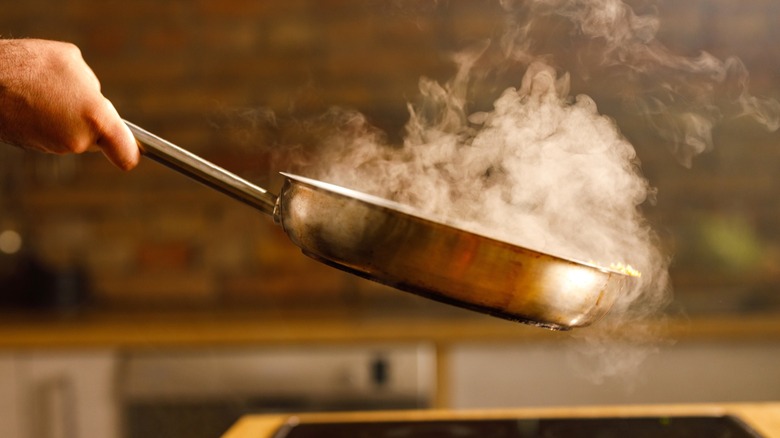The Biggest Mistake To Avoid When Cooking With Beef Tallow
If you've ever been to one of the restaurant chains that cook french fries in beef tallow, it's not an experience you will soon forget. The rich fat grants umami notes to food that other oils just can't provide. However, beef tallow — or any fat for that matter — can make food taste bitter or burnt if the heat gets cranked up too high. Abbie Gellman, a New York City-based chef, dietitian, consultant, and author, explained to us why that is, and how to avoid it.
The smoke point of oil is, somewhat obviously, the temperature at which oil begins to smoke. "When any fat reaches its smoke point, it will break down, meaning the temperature at which it will start to decompose," Gellman said. "When this happens, it creates noxious fumes and free radicals and the remaining fatty acids take on an unpleasant flavor." All the enticing savoriness of beef tallow is lost if the fat receives too much heat, leaving it to impart an astringent flavor that turns a promising ingredient into a tragic loss.
But, whether it's a fast food chain using beef tallow to cook its chicken, or it's any of us cooking fries at home, overheating the fat isn't the only concern in terms of flavor. Gellman noted, "In addition, the smoke point decreases every time an oil or fat is used — for example, a fryer at a restaurant." If an establishment isn't regularly changing the oil for its fryers, that bitter taste will rear its ugly head no matter what type it uses. That's something to bear in mind when using beef tallow to cook at home. As expensive as it can be, it will never be able to showcase its value if it gets reused for multiple cooks.
What temperature is too high for beef tallow?
Depending on the type of fat you're cooking with, it's a good idea to know the exact smoke point of your oil, which could land anywhere between 360 and 570 degrees Fahrenheit. As Abbie Gellman noted, "The more stable the fat, the higher the smoke point. [...] The smoke point of beef tallow is around 400 degrees Fahrenheit." Avocado oil is a good choice if you want to use higher heat, but you'll be missing out on all the umami that beef tallow has to offer.
Still, how many people check the temperature of cooking oil while they're whipping together a gastronomic gem? I know I certainly don't. But the dead giveaway that the fat is getting to hot, as one might assume, is when it starts to smoke. "Once a fat, including tallow, starts to smoke, then it has gotten too hot," Gellman said. "Definitely turn down the heat and try to keep it under its smoke point if possible."
Bitter flavor isn't the only concern when beef tallow reaches its smoke point. As fats break down at high heat, they can start to produce flammable fumes, creating a fire hazard. If you notice your fat bellowing smoke at an alarming rate, avoid burning your kitchen and your cuisine by removing it from the heat source for a moment to let it cool. Then try to find that sweet spot where food cooks properly without smoking up your kitchen.

